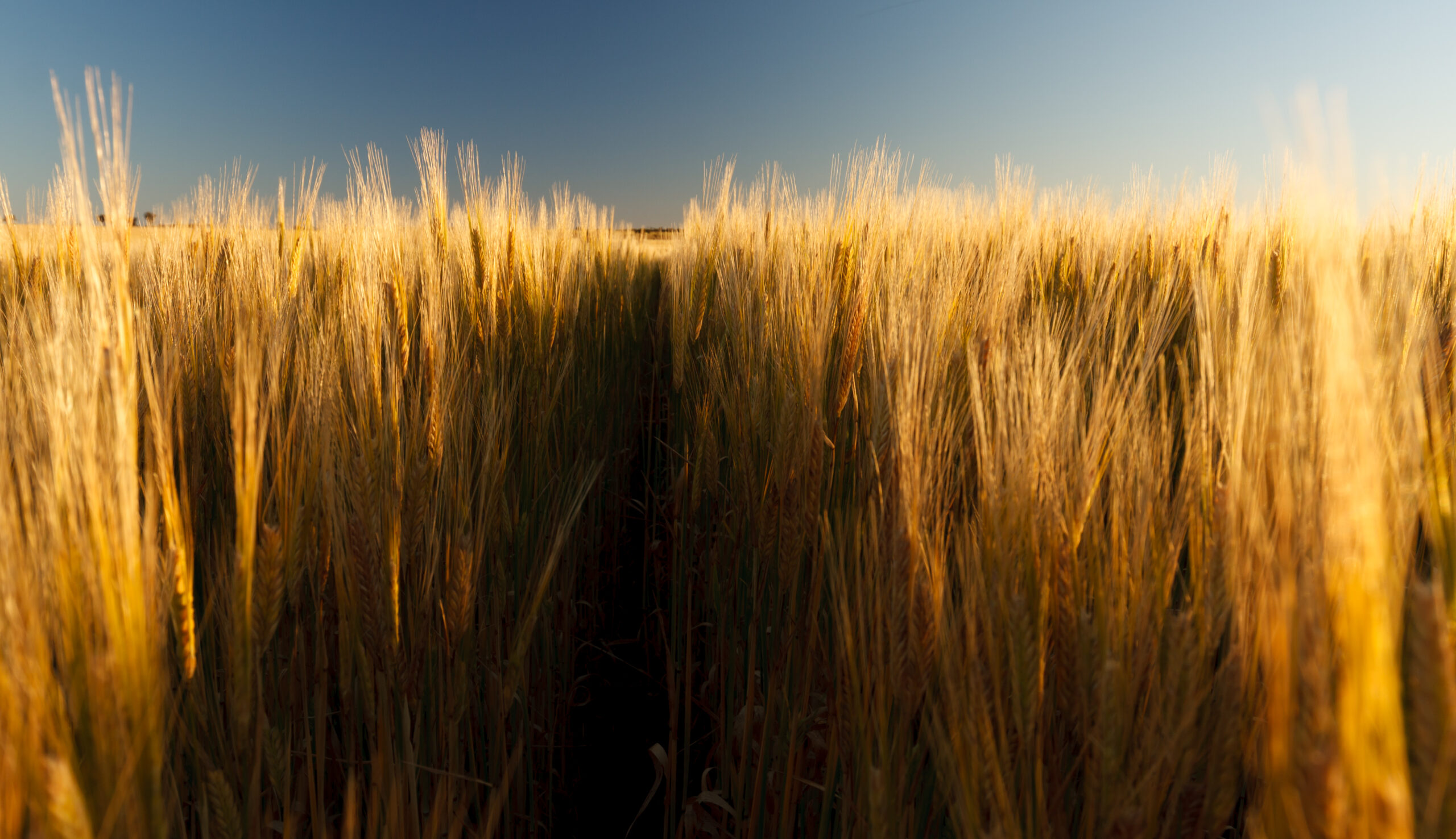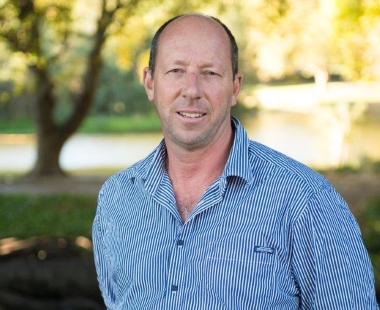Written by: Andrew Jones | Farm Business Consultant | 0456 688 171
‘Will you take an opportunity’?
or
‘Will you be an opportunity’?
Over the course of 40 years, the faces of farming in WA have not only changed but diminished in number.
In 1980 there were approximately 7,800 established Ag producers in WA. By 2022 this number has reduced to 5,725 established Ag producers managing 17.5M ha of cleared land in WA, representing a 26% reduction in established producers.
This may be attributed, at least in part, to increase scale in operations to fight against a declining trend in the Farmers Terms of Trade.
The Commodity Economy and Terms of Trade.
Through the passages of time, the ‘Commodity Economy’ (tangible goods production) has repeatedly witnessed growth of business through increased scale at the expense of smaller operators. This can be applied to almost any sector of production – e.g., Tractor manufacturers of volume products buyout (take-over) technically advanced manufacturers, or the emergence of supermarkets competing heavily with local butchers, bakeries and fruit & veg shops, ultimately making the volume of trade for the small business to become unprofitable.
This ‘Commodity Economy’ action is in contrast to the emergence of the ‘Experience Economy’ (the creation of emotion, enjoyment or excitement) in which ‘punters’ are seeking the experience of dining, adventure or atmosphere. In the experience economy, bulk processing does not and cannot compete with the provision of personalised services expected, nor can they charge for it. (E.g. Wedding services, the coffee shop culture, Skydiving, etc)
Farming is part of the ‘Commodity Economy’ and is therefore subject to competition by operations of scale. Operations at scale provide improved operating profitability and therefore increased capacity to absorbed industry participants that are suffering from declining ‘terms of trade’ and falling profitability.
The ‘Heavy Stuff’.
What is – Terms of Trade?
Farmers Terms of Trade (FToT)
The farmers’ terms of trade (FToT) refers to a suite of indicators that measure average changes to prices and farm costs of the agricultural sector. Price indexes measure the average growth in prices that farmers receive at the farm gate for their product, and in the prices paid for inputs to production.
Ref. (Department of Agriculture, Fisheries and Forestry. Australian Govt – ABARE)
The most common reference to Terms of Trade is the Nation’s accounts – refering to the values of Exports vs the value of Imports.
See diagram below:
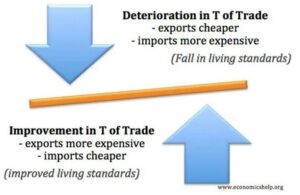
Whilst this represents a similar concept to farmers Terms of Trade – the capacity of the Terms of Trade to provide the necessary inputs for long-term operations is the key aspect of this metric.
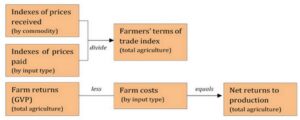
Note: GVP = gross value of production
Source: ABARES
In the FToT, measures of the net return to farm production (commodities) is derived by subtracting farm costs and depreciation from the gross value of agricultural production.
The prices received index is a weighted average measure of the change in the farmgate price of agricultural products. Prices received indexes are also available by commodity group, such as ‘crops’ and ‘livestock’. The prices paid index is a weighted average measure of input prices. The price indexes are available by input type, such as chemicals, feed and fuel.
[Ref. DAFF Home ABARES Research topics Agricultural forecasting Farmers’ terms of trade: Update to farm costs and prices paid]
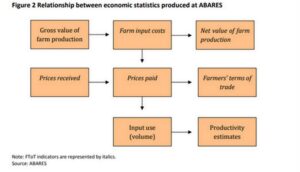
To better understand this table (Table 2), break it down into the individual rows.
The first row is a reflection of the Profit & Loss of the farm business.
- Gross value of Farm Production – Farm Input Costs = Net value of farm production. Sounds simple. However, gross value also includes carry-over production, the value of current assets at market values, the relevant values of non-current assets and adjustments for perished goods. It also does not take into account the relativity between inputs and outputs. This first row cannot be considered in isolation, as this ignores the relevant values of primary production vs required inputs.
- Prices received – prices paid = Farmers terms of trade
(Profit before tax). Profit before tax indicates an improved terms of trade which is used to meet the needs such as Capital payments, interest and personal benefits. All improvements to position. - The final line in the diagram asks the question of how much of the inputs is required and what productivity does this provide.
- In the case of say fertilizer or herbicides this is a simple consideration. A known quantity of active constituent is to be applied to get a result.
- This is less clear in the case of diesel fuel, or machine hours. This then challenges the periodic replacement policies of machinery and other inputs.
The following graph shows the relevant FToT as recorded by ABARE from 1994/95 – 2017/18. This graph shows two separate lines.
The first is the ‘Updated index’, representing the actual FToT for the individual years throughout the displayed period, whilst the second is an algorithmic trend line over that period.
Comparison of farmers’ terms of trade indexes, 1994–95 to 2017–18.
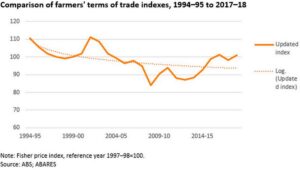
By way of example: (Over a 50 yr period)
1973 Toyota L’cruiser 2 door Ute. 3.0L Diesel 4 spd was $4,635. (redbook)
1973 1 tonne of ASW (FAQ in those days) FIS was $80/ metric tonne. (Macrotrends data)
Approx 58 tonne of wheat was required to buy a standard farm utility vehicle.
1997 Toyota L’cruiser 2 door Ute. 4.2L Diesel 5 spd was $14,500. (redbook)
1997 1 tonne of ASW wheat $197/tonne. (Trove – AWB Fin. performance)
Approx 74 tonne of wheat was required to buy a standard farm utility vehicle.
In 2022 a Toyota L’cruiser 2 door Ute. 4.5L V8 Diesel 5 spd. costs $76,650 (cars guide)
In 2022 a tonne of ASW wheat FIS is worth $276/tonne. (Macrotrends data)
Approx 277 tonne of wheat is required to buy a standard farm utility vehicle.
It’s fair to say the Landcruiser has improved in capability over time – but the task asked of the vehicle has largely not changed.
There should also be consideration given to productivity changes. The km’s required for the average farmers 1972 L’cruiser to travel to produce 1,000T of wheat would have been vastly greater than producing 1,000T in 2022. Does this mean the cost of the vehicle needs to spread over more years?
Take home message
Understand the Farmers Terms of Trade and how your business is tracking. There are 2 good indicators within the annual reports to observe.
- The gap between Operating profit and EBITDA – a narrowing of this gap indicates declining Terms of Trade. i.e. a declining capacity to meet non-operating cost expenditure.
- The long-term trend of Profit before Tax (EBITDA) will be a good indicator of the business’s terms of trade. A positive trend in EBITDA is a strengthening Terms of Trade.

